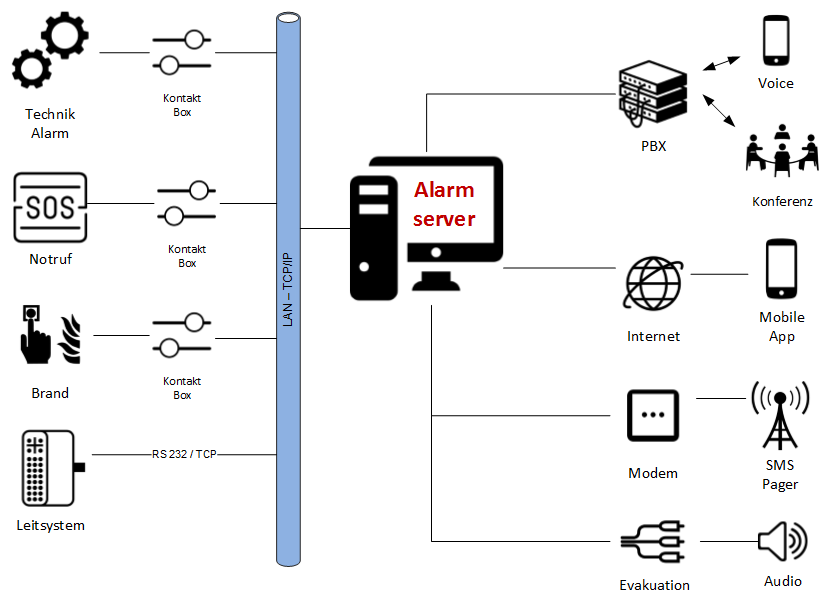Product - AMX Extra Large
AMX - Alarm Management Server
Alarming for life and technology
Technical problems, equipment failures, fire or water damage and similar incidents can have costly consequences for a business. In order to guarantee the safety of individuals, groups and infrastructure within an organisation, a rapid response to incidents is essential. The AMX (Alarm Management Server) developed by ATT guarantees that the right people can intervene to protect persons and infrastructure at the earliest possible time to minimise any adverse outcomes.
Using standardised interfaces, the AMX communicates with fire alarm systems, building and process control systems, check-in and check-out systems, and monitors network management as well as for example a nurse call system. Information about the event is forwarded as a voice message via a telephone call (TDM/VoIP) or in the form of text using a mobile app or as an SNMP trap, SMS or pager message.
Protection for Persons and Infrastructure
Combined text and voice messages via cordless terminals (DECT, Wi-Fi) can be deployed for in-house alarms. This allows entire buildings or parts of buildings to be evacuated quickly and efficiently. These powerful options are especially applicable to the hotel industry, where the AMX, in conjunction with check-in systems, can transmit fully automated messages to the guest's room in their native language.
Proven Hard and Software Concept
The AMX Alarm Management Server is already in its eighth generation and supports Windows 10 IoT Enterprise 64 Bit and Windows Server 2016. All AMX modules were developed according to international best practice standards and programming conventions using the latest WEB technologies and methods (ASP.NET, MS SQL, AJAX). A combination of rigorously tested software and industry standard hardware components guarantees that the AMX is extremely reliable.
ATT's consistent use of industry standards ensures simplified support, compatibility with third party systems and a high degree of investment protection
AMX - XLExtra Large

- RAID (X), SAS (HS)
- 1 x COM Port
- 2 x Powers. (HS)
- 2 x NIC
- Win. Server 2016 R2
- Input Interfaces (Unlimitiert)
-
- ESPA 4.4.4, Lineprotocol
- Dry contacts
- OPC AE / DA / UA
- BACnet, SMTP, SNMP
- Gets, Gets-Funk
- Modbus, Tyco
- Loneworker App, Alarm App
- ...
- Output Interfaces (Unlimitiert)
-
- PRI, BRI, VOIP (SIP,SIP-Q)
- Paging: OMM, CSTA, ATAS
- Paging: OAP, XML
- SMS, Pager, E-Mail
- Mobile App, Sound, Printer
- Mitel, Alcatel, Unify
- AVAYA, Gigaset, SNOM , Cisco
- MS Teams, Spectralink
- Redundancy
-
- HOT-HOT-HOT
- Loadbalancing
AMX - Grundausführung
- Ready-to-operate, preconfigured alarm server
- PBX connection over BRI, PRI, VoIP (SIP), XML, CSTA
- Event message processing via telephone call and dry contacts (RS232/IP)
- Alarm notifications forwarded to an unlimited number of in-house and external subscribers
- Alarm text messages sent to cordless DECT and Wi-Fi terminals, or desk terminals with display*
- Call intrusion and disconnecting existing conversations are definable for each alarm*
- Overriding call deviation*
- Confirming alarms with an announcement or password, or via XML, CSTA, DECT SMS*
- Alarm notification ends if x of ypeople have already confirmed receipt.
- Delay issuing an alarm (e.g. filtering brief power interruptions)
- Call repetition and escalation process
- Reporting (PDF, CSV , EXCEL, RTF, TIFF, Web Archive)
- Ad hoc documentation of system configuration
- Holiday calendar
- Recording and alarm time windows are definable for each day and event
- Self-monitoring and self-diagnostics
- Automated and prescheduled test alarms
- Import/export tool to change subscriber and interface data
- SQL database
- Backup tool
- Log archiving tool per module
- Internal watchdog process, Event Watch (OS)
- Alarm prioritisation(e.g. fire alarm before machine alarm)
- GUI for administration and configuration changes (persons, groups, events, etc.)
- System access audit trail (data logging)
*(depends on PBX features)
Universal Deployment
Using standardised interfaces, the AMX communicates with fire alarm systems, building and process control systems, check-in and check-out systems, and monitors network management and nurse call systems. In this way, the AMX offers central recording and processing for all occurring events. Due to its flexible configuration, the AMX can be easily tailored to monitor existing infrastructure and seamlessly integrate with customer processes and procedures.
The AMX is very versatile: from pure text transmissions to initiating an emergency conference call between several parties and/or groups, simple serial alarms or several nested alarm levels, and all can be carried out simultaneously. Manual ad-hoc alarms (text / voice / TTS) are just as easy as the completely centralised and automated processing of all external alarms.
Large Capacity and Constant Monitoring
Up to 32,000 dry contacts can be monitored over serial interfaces and/or via a company's internal LAN. One single AMX Server can support up to 270 voice connections, with each individual outgoing line dynamically assigned to an alarm depending on its priority. AMX can not only continuously monitor connected third party systems, but also proprietary modules and messages from the operating system
Return on Investment
Thanks to its compatibility with all modern PBXs, the AMX is easily deployed in any organisation and the investment in the AMX is secure, even if the PBX is upgraded or replaced.
AMX-Integrations
Alcatel-Lucent 4400 / OXO / OXE, Unify OpenScape Business / OpenScape Voice / OpenScape 5000, Nortel Meridian / CS1000, Avaya Aura & IP Office Communication Manager / Server, Panasonic TDA / TDE / NCP, Cisco CUCM, Mitel SIP DECT, MiVoice MX-ONE / A5000, MiVoice Office A400 / A700 / OpenCom 1000, Spectralink, Sykpe for Business, Wildix, 3CX, innovaphone, etc.
Module add-on
| Module add-on | Description |
|---|---|
| Native mobile apps | iPhone and Android |
| Interface controller | Monitoring and controlling interface events |
| Real-time monitoring | Monitor all ongoing events |
| Active personnel-monitoring | Man-down alarm, emergency call, active callback, customer-specific |
| Watchdog with contact output | Hardware platform monitoring |
| Watchdog with SMS or pager or e-mail output | Monitoring licensed software modules, including hardware |
| Alarm activation mask | Customer-specific images, e.g. to simplify an evacuation scenario |
| Protocol interfaces | Via IP (SNMP, e-mail, OPC, MOD Bus) and RS 232 (ESPA 4.4.4, ESPA Plus, line protocol, SPS, etc.); please ask for the complete list, over 40 different interfaces available |
| Duty plan, including absence calendar | Annual plan |
| Revision module | Deactivate alarm groups and alarm points for a service window |
| Linking primary and secondary alarms | Alarm categories |
| Hotel check-in, check-out | Fidelio, Rebag, etc. |
| Nurse call interface | Tyco, Gets, Ackermann, etc. |
| SMS (forwarding / monitoring) | Alarm notification via SMS |
| Pager (internal or external) | Alarm notification via pager |
| Email (forwarding / monitoring) | Alarm notification as an e-mail |
| SNMP trap (forwarding / monitoring) | Alarm notification as a SNMP trap |
| Alarm via phone call | REA (with or without ad hoc announcement), elevator alarm with voice transmission, emergency medical call, etc. |
| Conference call | Activating a conference call between persons targeted by an alarm (multi-conference calls) |
| Multi-Tenant Architecture | In-house departments or external companies with exclusive database access |
| Sound | Notification via audio systems |
| Ad hoc alarms | Recording or generating a new alarm message (text, voice, TTS), with password-protected activation and free selection of subscribers and their communication devices |
| Event printer | Continuous feed printer for issuing alarm logs |
| Browser interface | Intranet or Internet access |
| Redundant architecture | RAID I, dual-power supplies, redundant systems (master/slave or hot/hot) |
| Specialised applications | Additional customer-specific solutions can be developed |
Alarm server concept
Using standardised interfaces, the AMX communicates with fire alarm systems, building and process control systems, check-in and check-out systems, and monitors network management and nurse call systems. In this way, the AMX offers central recording and processing for all occurring events. Due to its flexible configuration, the AMX can be easily tailored to monitor existing infrastructure and seamlessly integrate with customer processes and procedures.
Technik Alarm
Potentialfreie Kontakte, Relais, ADAM Advantech, SNMP, OPC, KNX, Check-In / Out, Fidelio, Rebag, UTI (Textfile Analyse), ...
Alarmserver
Embedded System, virtueller Server, 19" Rack Version, Cloud, Windows Embedded System, Windows Server 2016, VMWare, Hyper-V, ESX, Citrix, ...
PBX
Mitel, Panasonic, Alcatel, Micorosft Teams, Avaya, Cisco, Unify, Polycom, BRI, PRI, SIP, SIP-Q, T0, T2, S0, S2, ISDN, DECT, WLAN paging, ...
Notruf
Personenschutz, REA Alarm, Notruf, Brandalarm, ...
Konferenz
Konferenzschaltungen, ...
Brand
Brandalarm, Gebäudesicherheit, Notrufsysteme, ...
Mobile App
Mobile Alarm App, Notification App, iPhone, Android, ...
Leitsystem
ESPA 4.4.4, ESPA Plus, Line Protokoll, SPS, KNX, Cerberus, Siemens, Securiton, Honeywell, TICOS, ...
SMS / Pager
SMS, 2 Weg SMS, Pager, E-Mail, PSA, Textfile (UTI), FAX, Drucker, Voice, ...
Audio
Evakuation, Beschallung, Avidec, ...
Alarm server appliance
The new AMX embedded systems are stable and are equipped with redundant SSD hard drives without rotating parts. The advantage lies in the robust design and the components, guaranteed by the industry standard (less vulnerable to shocks, damp and heat). Thanks to the AMX embedded system, ATT assures their customers a system that is expandable and that is suitable for the technical space in any location, due to its physical size.
1995 © ATT AG. ALL Rights Reserved - Swiss Made Products Contact - Support - Data privacy statement

